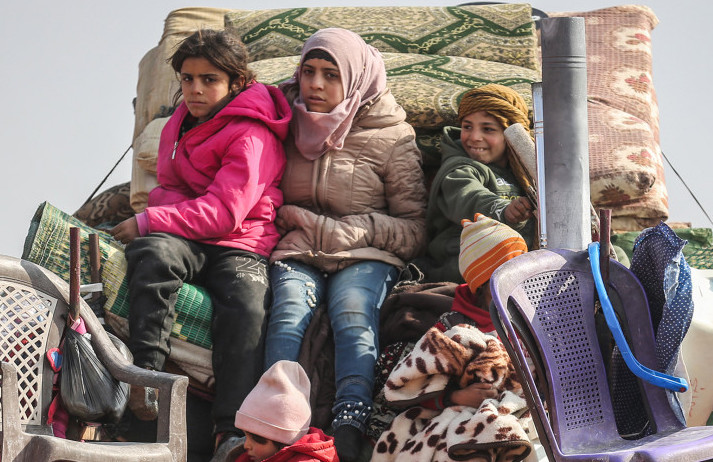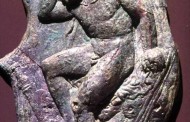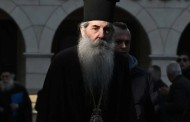
Chloe Cornish in Beirut and Asmaa al-Omar in Istanbul 14 HOURS AGO Print this page67 The old airline tags on the five suitcases by the front door hint at a family holiday. But Muzna is not packing for a fortnight away; she is fleeing Syrian and Russian fighter jets. Bombs exploding in nearby Idlib city have convinced the 32-year-old mother of two that she needs to move — for the second time in two months — but this time she is not sure where to go. “There is stuff we can’t take with us,” she says, things like crafts made by her sons, aged four and six. She has a photo of her youngest holding a collage — a number “4” made from glittery paper hearts, with three warplanes hovering above. They had already left that picture behind. Outside her window, the cold streets of Maaret Misrin — a town 10km north of Idlib city — are jammed with loaded cars, families desperate to escape the bombing but with little option of where to go. After nine years of civil war, which has caused exodus after exodus from Syrian cities crushed to rubble, Muzna has seen this all before. “If they could, they’d probably take the bricks [of their houses],” she says, “because they know once the regime forces come they will burn everything and leave our town without a single hut.” The Syrian civil war has forced half the population from their homes. Many have sought refuge in Europe © Khalil Ashawi/Reuters Muzna, who asked not to give her family name, was like others interviewed in Idlib by the Financial Times, reached by telephone. The women’s rights activist, her doctor husband and two sons are just four of some 3m civilians trapped in north-west Syria close to the Turkish border, where an intense bombing campaign and advancing ground assault by forces loyal to President Bashar al-Assad have forced more people to flee in a short period than at any other time since the conflict erupted in 2011. The UN says that in the past 10 weeks, 800,000 people have run for their lives. The vast majority — 80 per cent — are women and children. A September 2018 agreement between Russia, Iran and Turkey — the Syrian war’s main international players — had until last spring slowed the regime’s advance on Idlib. Ankara, which backs many of the remaining militant groups opposing Mr Assad, had promised to separate out the opposition fighters they support from jihadis formerly linked to al-Qaeda. If Turkey could push the jihadis far enough away that they could not threaten Russian bases, Moscow pledged to restrain its ally Damascus. But both eventually blamed the other for failing to stick to the bargain, and by April 2019, the offensive was back on. Multiple ceasefires have since failed. Home to hundreds of thousands of people who escaped other battles, Idlib is the final opposition-held enclave. It is now the scene of an unfolding humanitarian disaster and the dying days of Syria’s revolution. The civil war has left at least 500,000 people dead, forced half the population from their homes and pushed millions to seek refuge in the Middle East region and Europe. Idlib is “the last area where these people can be free”, says Jomana Qaddour, co-founder of the Syria Relief and Development aid organisation. “[That is why] the fate of Idlib is so important — not just to the people that live there but to all Syrians that went out demanding their freedom and dignity.” The regime is pushing west, its warplanes emptying town after town before its tanks roll in. But with the Turkish border shut and towns along it already bursting at the seams, there is almost nowhere left for the trapped Syrians to run. Aid groups say space to erect tents in the rocky terrain is scarce. Hospitals, schools, warehouses full of aid — even camps for the fleeing — have been hit in air strikes by pro-Assad forces. Winter temperatures are below freezing. Mark Cutts, the UN’s deputy regional humanitarian co-ordinator for Syria, says aid agencies sent 1,200 trucks of emergency supplies over the border into Idlib in January: “But do we have enough? No. Are we on top of things? No. The scale of the crisis is enormous. Muzna, a 32-year-old mother of two, is moving her family to avoid Syrian and Russian attacks on one of the last rebel-held areas in the country Since 2017, the Syrian army and militias loyal to Mr Assad have reclaimed rebel-held cities and territories in the south and centre of the country. But the regime is not in full control of the north-east, governed by a Kurdish-led administration that does not oppose Mr Assad but wants some independence from him. Nor does it hold a corridor of the north-west by the Turkish border, which Ankara controls. But it has taken back most of the country — a scenario unthinkable before first Iran, and by 2015 Russia, threw their military weight behind Mr Assad, decisively turning the tide of war in his favour as he vowed to take back “every inch” of Syria. He and Vladimir Putin, the Russia president, insisted they were fighting terrorists. Through all this, a once obscure corner of north-west Syria, the province of Idlib and western parts of neighbouring Aleppo, eluded Mr Assad. Instead, the regime herded hundreds of thousands who refused to reconcile into the area, approximately doubling the size of Idlib’s population since 2011. A survey by the International Rescue Committee in Idlib last year found that families living there had on average moved five times since the start of the civil war — with 16 per cent reporting they had been displaced 10 times or more. Those bussed into Idlib included rebels backed by neighbouring Turkey, which has been organising, arming and training anti-Assad forces since 2012. Yet a former offshoot of al-Qaeda, Hayat Tahrir al-Sham, toppled Turkey-backed rebels and over-ran Idlib last year. Numbering as many as 10,000 fighters, according to the US’s Syria envoy James Jeffrey, HTS’s funding comes largely from levying tariffs at border crossings, land sales and local taxes. The civilians who reluctantly live under jihadist rule include people like Muzna, who previously fled from the town of Maarat al-Numan — 33km south of Idlib city — before regime forces arrived a month ago. Protecting her sons is her priority. But the boys “know the regime entered our house, the kindergarten and [our town],” she says. “They would tell me, ‘mum, they are burning [the drawings] now’.” She has reason to fear. “What’s happening now never happened before. We can’t go anywhere,” says Aref Tammawi, a Syrian photojournalist in Idlib who fled Aleppo and has witnessed multiple mass displacements during the war. “It looks like judgment day.” Timeline Years of conflict and proxy war 2011 Civil war breaks out. The US and EU impose sanctions on Syrian regime over alleged human rights abuses. 2012 Turkey and other nations opposed to President Bashar al-Assad begin to arm and train rebel groups. 2013 Syrian regime accused of carrying out chemical weapons attack in Damascus suburbs — but crossing Barack Obama’s “red line” does not lead to western retaliation. 2014 Isis captures swaths of territory in Syria and Iraq. 2015 Russia deploys its air force to help the Syrian regime. Convoys of refugees make their way to Europe. 2016 The regime retakes Aleppo from the rebels. Turkey establishes areas in north-west Syria under its control. 2018 Regime regains swaths of territory, including southern provinces. 2019 Isis loses its last scrap of land. Turkey launches new offensive against US-allied Kurdish forces. Tarek, not his real name, was born into a comfortable family in Idlib in 2000, the year Mr Assad succeeded his father Hafez to become Syria’s president. The British-educated Mr Assad courted the west — but growing economic inequality and unpopular authoritarian rule led to unrest and eventually revolution. By the time Tarek turned 11, the Arab spring had ignited Syria’s civil uprising. “I joined the peaceful protests in 2012,” Tarek says. It would change his life, and his country, forever. Turkish-backed Syrian fighters in Sarmin, 8km southeast of Idlib. Turkey has been training anti-Assad forces since 2012 © Omar Haj Kadour/Getty Alarmed by the scale and size of the demonstrations, Mr Assad decided to crush the uprising. “I saw my friends, kids, falling [with our] bare chests, calling for freedom in front of the Syrian regime bullets,” Tarek says. The baker’s son says he was 14 when he first picked up a gun to fight the regime. The Syrian civil war soon became an international proxy battle. While Iran and Russia backed Mr Assad, seeking to prevent regime change, Gulf states and western nations sent weapons and money to rebels. Islamist extremist factions rose out of the opposition melee and at times the factions fought among themselves. After the Assad regime, backed by Russian air power, pummelled the rebels into submission, the stronger jihadi groups such as HTS came to dominate Idlib. With more moderate factions eventually defeated, western backers retreated, but one nation stayed: Turkey. Today, 20-year-old Tarek leads a group in the Turkish-backed National Liberation Front, one of the groups that make up the rebel Free Syrian Army. Some fighters, including Tarek, are agnostic about Ankara’s role. “There were a lot of arguments among us when it came to receiving foreign support,” he says. But Turkey and its Syrian proxies — many of them hardened Islamists — are deeply entwined. They have fought alongside Turkish troops in three separate military incursions into Syria since 2016. Ankara has expended huge resources on capturing, holding and governing territory, and lost scores of soldiers. Now President Recep Tayyip Erdogan is trying to hold another Syrian front line, this time in Idlib. Recommended Middle Eastern politics & society Middle East’s demographic earthquake: the generation fuelling protests A key driver for Ankara is the desire to avoid a new wave of refugees. The country has won praise for hosting 3.6m Syrians but, as public opinion has soured, Mr Erdogan has warned that it cannot accommodate any more. Yet countering Mr Assad is proving costly. Funerals were held last week for five Turkish soldiers killed by Syrian regime shelling. The attack — the second to target and kill Turkish troops in just over a week — coincided with meetings between Russian and Turkish envoys and was “a kind of declaration of war against Turkey”, says Omer Ozkizilcik, an analyst at the SETA Foundation think-tank in Ankara, a message “that the [Assad] regime is willing to use military force”. For Ankara, the risks are growing — no longer conducting war primarily through proxies, but increasingly committing its own soldiers. Mr Erdogan warned on Wednesday that the Turkish military would retaliate against Syrian attacks “by any means necessary”. But Moscow and Ankara have a bigger strategic bilateral relationship to protect. “If the fighting in Idlib grows so bad that relations start to unspool, I think both Putin and Erdogan will be very concerned,” says Aron Lund, a fellow at the Century Foundation. Although Mr Assad badly needs Mr Putin’s help, Moscow’s power over Damascus is as constrained as Turkey’s to defang the jihadis. “Here Russia is in a very tricky position because by actually coming into Syria and deploying its air forces it got sort of trapped,” says Alexey Khlebnikov of the Russian International Affairs Council. “The only leverage Russia has is to increase or decrease the level of air support to Syrian army advancements.” The Kremlin has said that it does not regard the situation in Idlib as a military battle, but as a justified act by Syrian troops against terrorists. “This is not about conflict,” Vladimir Putin’s spokesman Dmitry Peskov said on Thursday. “We are talking about the fight against terrorism waged by the armed forces of the Syrian Arab Republic in their own country.” Air strikes on Idlib by pro-Assad forces have hit hospitals, schools, warehouses full of aid and civilian camps © Ghaith Alsayed/AP But HTS is unlikely to back down. Taqi al-Din Omar, the group’s media official, accepts that it has lost territory but says “the will to fight remains strong within the sons of this revolution”. “They’re going to put up the strongest fight they have,” says Dareen Khalifa, an International Crisis Group researcher who visited Idlib this year. “[For HTS] it’s going to be the last battle”. In Akrabat near the Turkish border, Samih Kaddour is braced for the worst. “I think we are next in line if the regime continues to advance,” says the softly-spoken medic, who fled Aleppo to work in the remote town’s hospital. Civilians have grown used in recent years to dealing with armed groups who have tried to tax them or introduce more hardline Islamic rule. But, says Dr Kaddour, Hayat Tahrir al-Sham has not directly interfered with his hospital. There are no good options for people like Dr Kaddour, who chafe against the jihadis but reject the regime’s return. More than 70 medical facilities in and around Idlib have suspended their work amid the violence. A Syrian employee of Médecins Sans Frontières who visits camps in Idlib, says the shelter shortage is already so acute that tents are being used to accommodate up to three families at a time. “We need an end to the violence immediately,” says Misty Buswell, Middle East policy director of the IRC. “But even with a ceasefire there is a humanitarian catastrophe that’s happening in Idlib right now.” At this point, the best outcome the civilians stuck in Idlib can hope for is probably a permanent stalemate. The “hilly terrain up on the Turkish border where the majority of camps already are, that could be where more people flee to”, says the UN’s Mr Cutts. “That already is beginning to look more and more like a Gaza strip . . . people will be hemmed in, in a very small area, where the great majority are displaced.” Additional reporting by Laura Pitel in Ankara and Henry Foy in Moscow
financial times


 ο ψηφοφόρος της κλανιόλας
ο ψηφοφόρος της κλανιόλας












